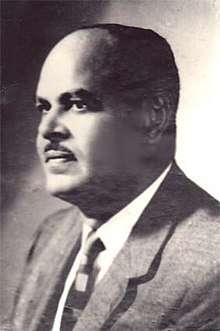Mohamed Sedki Sulayman
Mohamed Sedki Sulayman (1919 – 28 March 1996) was an Egyptian politician and 31st Prime Minister of Egypt from 10 September 1966 to 19 June 1967.
Mohamed Sedki Sulayman | |
|---|---|
محمد صدقي سليمان | |
 | |
| Prime Minister | See list
|
| Preceded by | Mohammed Naguib |
| Succeeded by | Anwar Sadat |
| 31st Prime Minister of Egypt | |
| In office 19 June 1967 – 28 September 1970 | |
| President | Himself |
| Preceded by | Muhammad Sedki Sulayman |
| Succeeded by | Mahmoud Fawzi |
| In office 18 April 1954 – 29 September 1962 | |
| President | Muhammad Naguib Himself |
| Preceded by | Muhammad Naguib |
| Succeeded by | Ali Sabri |
| In office 25 February 1954 – 8 March 1954 | |
| President | Muhammad Naguib |
| Preceded by | Muhammad Naguib |
| Succeeded by | Muhammad Naguib |
| Deputy Prime Minister of Egypt | |
| In office 8 March 1954 – 18 April 1954 | |
| Prime Minister | Muhammad Naguib |
| Preceded by | Gamal Salem |
| Succeeded by | Gamal Salem |
| In office 18 June 1953 – 25 February 1954 | |
| Prime Minister | Muhammad Naguib |
| Preceded by | Sulayman Hafez |
| Succeeded by | Gamal Salem |
| Minister of the Interior | |
| In office 18 June 1953 – 25 February 1954 | |
| Prime Minister | Muhammad Naguib |
| Preceded by | Sulayman Hafez |
| Succeeded by | Zakaria Mohieddin |
| Chairman of the Revolutionary Command Council | |
| In office 14 November 1954 – 23 June 1956 | |
| Preceded by | Muhammad Naguib |
| Succeeded by | Post abolished |
| Secretary General of the Non-Aligned Movement | |
| In office 5 October 1964 – 8 September 1970 | |
| Preceded by | Josip Broz Tito |
| Succeeded by | Kenneth Kaunda |
| Chairman of the Organisation of African Unity | |
| In office 17 July 1964 – 21 October 1965 | |
| Preceded by | Haile Selassie I |
| Succeeded by | Kwame Nkrumah |
| Personal details | |
| Born | Mohamed Sedki Sulayman 15 January 1918 Alexandria, Sultanate of Egypt (now Egypt) |
| Died | 28 March 1996 (aged 78) Cairo, Egypt |
| Nationality | Egyptian |
| Political party | Arab Socialist Union |
| Spouse(s) | Tahia Kazem |
| Children | 5, including Khalid |
| Profession | Military Officer |
| Signature | |
| Military service | |
| Allegiance | Egypt |
| Branch/service | Egyptian Army |
| Years of service | 1938–1952 |
| Rank | |
| Battles/wars | 1948 Arab–Israeli War |
Between 1962 and 1966, he was the minister supervising building of Aswan High Dam.
Six-Day War
During Sulayman's last month as Prime Minister, the Six-Day War was fought from 5 to 10 June 1967 by Israel and the states of Egypt (known then as the United Arab Republic [UAR]), Jordan, and Syria. The outcome was a decisive Israeli victory. Israel took effective control of the Gaza Strip and the Sinai Peninsula from Egypt, the West Bank from Jordan and the Golan Heights from Syria.
Central Audit Organisation
Muhammed Sedki Sulayman was the head of Central Audit Organisation (CAO) of Egypt between 15 November 1971 and 17 January 1978 .[1]
Death
Sulayman died on 28 March 1996.[2]
References
- Central Audit Organization, Egypt. Archived 2011-04-20 at the Wayback Machine
- "March 1996". Rulers. Retrieved 10 April 2013.
| Political offices | ||
|---|---|---|
| Preceded by Zakaria Mohieddin |
Prime Minister of Egypt 1966–1967 |
Succeeded by Gamal Abdel Nasser |